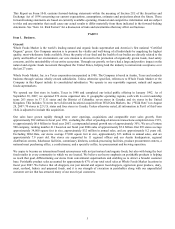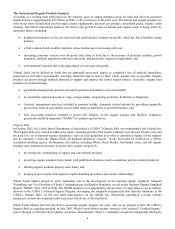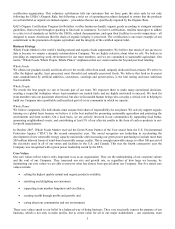Whole Foods 2007 Annual Report Download - page 18
Download and view the complete annual report
Please find page 18 of the 2007 Whole Foods annual report below. You can navigate through the pages in the report by either clicking on the pages listed below, or by using the keyword search tool below to find specific information within the annual report.
12
competition. We plan to continue to selectively sign larger sites, which showcase extensive prepared foods and sit-down
venues, but going forward, we expect them to be predominantly in dense urban markets or relocations of some of our very
successful existing stores.
As shown in the table above, our total gross square footage and average size of stores in development were lower in fiscal
year 2007 than in fiscal year 2006. This was due primarily to two factors: more stores exiting the development pipeline as the
acceleration in our new store openings materializes, and a decrease in the average size of new leases signed during the year.
Tender dates provide some visibility on the timing of our new store openings. For accounting purposes, a lease is considered
tendered on the date we take possession of the leased space for construction and other purposes, which is typically when the
shell of the store is complete or close to completion. As of November 20, 2007, 20 of our 87 stores in development had been
tendered to us. These 20 stores represent approximately 916,000 square feet.
The “tender period,” which we define as the length of time between a store’s tender date and opening date, varies depending
on several factors, some of which are outside of our control. These factors include the size of the store and complexity of site
development, the impact of weather and unforeseen environmental issues, and issues surrounding construction labor unions
and local government authorities, among other things. Furthermore, acquired leases, ground leases and owned properties
generally have longer tender periods than standard operating leases because we take possession of these locations earlier in
the construction process. For stores opened during the past three fiscal years, the average tender period was 8.7 months.
The following table provides information about the Company’s store development activities:
Properties Total
Stores Opened Stores Opened Tendered Leases Signed
During Fiscal During Fiscal as of as of
Year 2006 Year 2007 November 20, 2007 November 20, 2007
Number of stores (including relocations) 13 21 20 87
Number of relocations 2 5 4 22
Number of lease acquisitions, ground leases
and owned properties 1 4 9 13
New markets 4 3 1 14
Average store size (gross square feet) 50,200 56,500 45,800 51,200
As a percentage of existing store average size 147% 167% 133% 148%
Total square footage 653,000 1,185,800 915,900 4,485,200
As a percentage of existing square footage 10% 13% 10% 48%
Average pre-opening expense per store (1) $2.0 million $2.6 million
Average pre-opening rent per store (1) $0.7 million $0.9 million
Average tender period, in months 7.8 8.8
(1) Average pre-opening costs are estimated for projects not yet final and exclude the Kensington store in London.
Site Selection
Most of our stores are located in high-traffic shopping areas and are either freestanding or in a strip center. We also have a
number of urban stores located in high-density, mixed-use projects. In selecting store locations, we use an internally
developed model to analyze potential markets based on various criteria such as education levels, population density and
income levels within certain drive times. We primarily seek to open large-format stores, which typically range in size
between 45,000 to 60,000 square feet and are located on premier real estate sites, often in urban, high-population locales.
After we have selected a target site, our development group does a comprehensive site study and sales projection. Each
project must meet an internal EVA hurdle return, which is generally cumulative positive EVA within seven years.
The required cash investment for new stores varies depending on the size of the store, geographic location, degree of work
performed by the landlord and complexity of site development issues. For stores opened during the past two fiscal years
excluding Kensington, the average size was 52,700 square feet and our new store investment averaged approximately $14.4
million excluding pre-opening and relocation expenses, which averaged approximately $2.4 million per store.
























